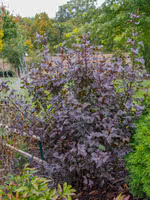Mon-Fri 9am - 5pm Mountain time
Western Snowberry vs Diablo Ninebark
Symphoricarpos occidentalis
Physocarpus opulifolius Diablo
NOT AVAILABLE THIS SEASON - MIGHT RETURN
Like the Common Snowberry, the Western Snowberry is a small shrub with pink flowers useful for feeding livestock and preventing erosion. Unlike the common species, however, the Western Snowberry is much more suited to wet conditions, capable of persevering through poor soil drainage and occasional flooding.
After the Snowberry's flowers have bloomed, it produces berries which often last on the plant through winter. These berries are toxic to humans, but livestock and local wildlife love them! Those hoping to attract wildlife to their property can plant Snowberry and expect to see animals foraging on it much later in the year than other plants.
Diablo Ninebark is a small, low maintenance, multi-stemmed shrub, that is used to add texture or color to any yard. This plant grows dark purple leaves in the spring and grows slightly faster than Common Ninebark. It features flaky red to brown bark, clusters of white flowers, and long, maple-like leaves. Diablo Ninebark can make a dense and colorful hedge, or it can be an attractive ornamental by itself.
Western Snowberry Quick Facts
Diablo Ninebark Quick Facts
Toxicity: berries are toxic to humans

